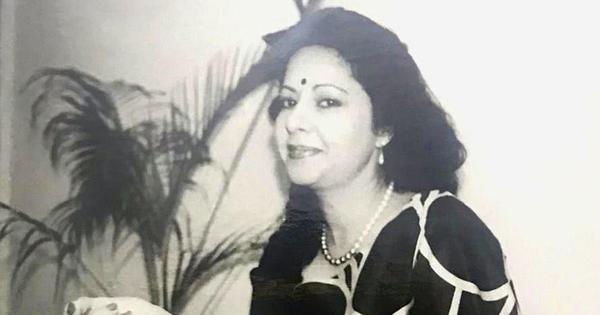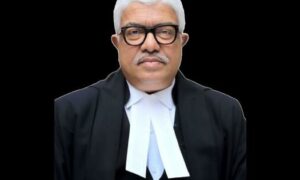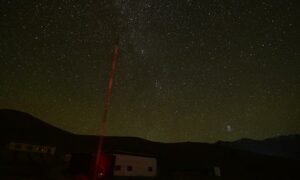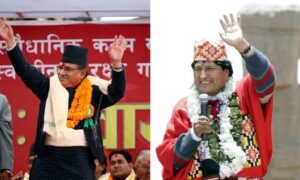
The transition from black-and-white to colour on Doordarshan marked a pivotal moment in Indian broadcasting, coinciding with the channel’s shift to national telecasts. While early telecasts were primarily local and in black-and-white, the move to national programming demanded greater visual appeal and clarity, which colour television provided. The gradual visual change came to symbolise the evolution of Indian television – from modest regional beginnings to a vibrant, unified national presence that reached homes across the country.
Dr Govind Gunthey, who was DD’s news editor at the time, reflects on the time Doordarshan decided to start national broadcast:
The launch of national broadcasts in 1982 marked a major milestone in Doordarshan’s growth and outreach. Under this, all Doordarshan centres of the country would connect with Delhi TV kendra at eight every night. The broadcast would begin with a Hindi news bulletin of half an hour. Later, at 9 pm, an English news bulletin for half an hour would be telecast. Since both the news bulletins fell under national broadcast, special attention was paid to prepare them. The presentation of these was different from all other bulletins.
Each news broadcast featured two newsreaders. Both the English and Hindi segments concluded with a two-minute weather report. In addition to regional coverage, Doordarshan also presented news in Urdu and Sanskrit, along with a dedicated segment for the hearing and speech impaired.
Doordarshan’s newsreaders carried out their roles with utmost professionalism, earning a lasting place in the hearts of millions across the country. Many of them are still fondly remembered by viewers today, and their era of news presentation is often hailed as the “golden age” of television news in India. They are all well remembered for their distinctive style of presentation with poise and confidence. Some of the popular names are Salma Sultan, Minu, Sarla Maheshwari, Sheila Chaman, Neethi Ravindran, JV Raman, Sunit Tandon, Tejeshwar Singh and others.
On August 9, 1984, Doordarshan launched its second channel for its metro/urban audience. The first DD channel was renamed as DD 1 and the new one was called DD 2 (also known as DD Metro). The second channel was launched by the then prime minister of India at a special function held at the auditorium of the Asian Games Village in Delhi. Over time, it expanded its reach to other major cities, including Bombay, Calcutta and Madras. In 1993, the channel underwent rebranding and came to be known as DD 2 Metro.
I was invited to deliver the opening announcements for the launch of DD 2. The producer wanted a shot of the massive satellite dish, with me standing in front of it. But from ground level, I blocked part of the structure, especially its curved lower edge, making it impossible to capture both me and the full dish in a single frame. So, they placed a small wooden table in front of the dish, and I stood on it. The elevation brought me in line with the dish’s central axis – the sweet spot where its circular shape and central antenna came into perfect view. From this angle, the camera could tilt slightly upward and frame everything neatly: the entire dish in all its symmetry and me in the foreground, no longer an obstruction but part of the composition – exactly as the producer had imagined.
The unsteady legs of the rickety table made me nervous as I gingerly stepped on it, dressed in my sari, holding the microphone in hand. I felt like a juggler at a circus. The script was well memorised and I tried to put a smile on my face for the camera. There were many retakes, as the script was long, and I often either forgot some words or mixed up the lines. But eventually it got recorded to the producer’s satisfaction and was telecast during the launch of the satellite and the new channel the next day.
Around the same time as the launch of the new channel, several fresh faces were making their entry into the television arena. One of them was the mellow-voiced Sangeeta Bedi, who joined as an English newsreader. She wrote to me, recalling her time on Doordarshan:
In 1984, I decided to audition for the position of casual newsreader at Doordarshan in Delhi. The first round of the audition was completed. Soon afterwards, the then prime minister Indira Gandhi was assassinated, and mayhem prevailed.
There was no revert from DD for a few months and during that time one thought it was to be a forgotten story. Suddenly, in March 1985, a telegram arrived, asking me to appear for the second round of audition and interview! A couple of weeks later, I began my journey on Indian TV, reading the Parliament news bulletins, later graduating to the prime time 9.00 p.m. news. I had the great privilege and honour of working with stalwarts like Neethi Ravindran, Tejeshwar Singh, Minu Talwar, Komal GB Singh, Ramu Damodaran, Preet KS Bedi, Gitanjali Aiyar, Sunit Tandon, Sheila Chaman, to name a few.
I remember Sheila as she was Miss Young India; I was struck by her personality. The spirit of camaraderie amongst all professionals, including the accomplished editors, producers, technical staff and make-up artists, made it a thoroughly enjoyable and satisfying experience.
I did go through training under the exacting standards accorded by Mr Sushil Jhaveri, chief newsreader at AIR, for pronunciation, delivery and modulation. However, most of the learning was done on the job. One incident from my journey comes to mind.
Fast forward to December 13, 2001, I was on duty to read the 2 pm bulletin at the then office and studios of DD on the fifth floor, adjacent to the Akashvani Bhavan. Once all set, I decided to go down for a quick cup of coffee. Remember, this was an era of no mobile phones. While sipping coffee, I noticed a flurry, and then someone ran towards me, shouting my name and asking me to rush to the studios, saying that there had been an attack on the Parliament building! With just this much information, I ran towards the studio and was soon facing the cameras. I was instructed to do a live commentary based on whatever visuals I could see on the monitor (the camera team, of course, had been sent there by then). At that point, one was not certain whether it was a terrorist attack. Giving it my best, I just spoke impromptu, relaying whatever I thought could have occurred. Later we learnt that five armed assailants had carried out the dastardly attack and we had ended up losing six Delhi Police personnel and a gardener. Overall, having been a small part of the great institution that Doordarshan was and always will be has been a very exciting, satisfying and joyful journey, one full of great learning.
The year 1984 holds a special place in the memories of those who worked at Doordarshan at the time. The launch of the second channel, DD 2, was no small feat. This marked a significant expansion from the single-channel format that had defined Indian television until then. With DD 2, programming could now be diversified, allowing for more entertainment content, while DD 1 focused on news and national broadcasts. It brought greater creative freedom, a broader reach, and the excitement of shaping a new viewing experience. For many at Doordarshan, it was a moment of pride – a clear sign that the organisation was growing, evolving and stepping into a new era.
Mr Y Venkateswarlu, who was fondly and commonly known as Mr Lu, was one of the most experienced engineers at Doordarshan and a witness to the technical advancements taking place in TV kendras. He remembers what followed after the launch of DD 2 and the national tragedy that struck soon after.
Following the launch of DD 2, the rollout of 100 television transmitters that year marked a major milestone in Doordarshan’s expansion. The expansion was very well planned at the headquarters in terms of the type of transmitters to be used at each of the selected locations, the frequency band of operation, finalizing specifications and sourcing of equipment, identifying the staff, training and posting them and addressing the teething problems that arose during the operationalisation of the equipment.
The officers on site found themselves handling different sets of responsibilities. The zonal offices in the four metro cities played a crucial role in supporting the effort. From organising the inaugural function to the satisfaction of all attendees, to managing equipment failures during installation or immediately after commissioning – engineers faced a range of challenges. At times, equipment had to be temporarily diverted from nearby projects to complete installations, simultaneously arranging repairs or replacements for faulty components. We learnt to adapt quickly and rise to the occasion, crisis after crisis.
The year also posed a major challenge for Doordarshan—to maintain uninterrupted services and telecasts amid the turmoil in Delhi following the assassination of Prime Minister Indira Gandhi. On the morning of October 31, 1984, as I stood in front of Akashvani Bhavan, a staff member came running towards me, saying, “Director [Television Centre] saab aapko bula rahe hain, bahut urgent hai (The director is calling you, it’s very urgent).” I quickly reached the director’s chamber. There were a few people in the room besides the director himself.
He told me, “Turant OB van lagana hai (The OB van has to be positioned immediately). On being asked about the location, he replied, “I will let you know.” He then told me about the assassination attempt on Mrs Gandhi. We were all shocked beyond words. I was told to come back after making all arrangements. I went to my room, contacted all the key people involved in OB coverage, and then reported back to the DTC (director, Television Centre).
The OB van was set up, and the coverage was carried out successfully. Once the set-up was dismantled and the OB staff had returned home, I received a call from the director general of Doordarshan. Another OB assignment had to be arranged in the early hours of the next day. It was later revealed that the van was to be stationed at Teen Murti Bhavan, where Indira Gandhi’s body lay in state. Dignitaries and citizens from all walks of life were expected to gather there to pay their final respects to the late prime minister.
I told him, “Sir, you know it is not possible to plan a coverage of this scale at such short notice.” To that, he said, “I told them so but they are insisting, and they will provide all assistance.” I immediately rushed to the transport department and – despite there being limited staff because of the unrest in the city – we drew up a list of the staff and officers who could be picked up from their homes the next morning.
Three hours later, we moved the OB van to Teen Murti Bhavan. I walked back to my residence which was about 2 km away in the dead of night in the eerie silence that prevailed all around. There had been sporadic police firing throughout the day, including in areas adjacent to the Doordarshan newsroom. Despite the unrest, the live coverage was carried out efficiently the next day by an exhausted team. In that moment, I knew – this was how the officers and staff at the Delhi kendra rose to the occasion in times of crisis, driven by deep commitment to their work.
The OB van remained stationed at Teen Murti Bhavan for three days for the live coverage. Despite the citywide unrest and the challenges faced by the staff in commuting, all critical positions – both in the OB van and across technical areas at the kendra – were manned without fail. There was no break or interruption in transmission.
On November 3, 1984, the funeral cortege made its way to the cremation ground (now known as Shakti Sthal), and it took about four hours to cover the 10-km route. The massive procession, attended by thousands, was broadcast live through microwave linkages set up at key points along the route, as DD did not yet have Digital Satellite News Gathering technology. The coverage of the cremation was carried live by the DD network and was witnessed by the entire nation. Hundreds of dignitaries and thousands of people were present at the venue. Needless to say, the DD staff worked with great commitment in providing the coverage. This was perhaps one of the most difficult assignments that the Delhi kendra had handled.
Despite limited resources, Doordarshan’s live coverage of Indira Gandhi’s funeral in 1984 marked a defining moment in India’s broadcast history. Using only microwave link chains and OB vans – without modern satellite technology or digital tools – engineers managed a seamless, real-time telecast across multiple locations during a period of national unrest. This technically complex operation, carried out amid riots and curfews, showcased Doordarshan’s operational maturity and commitment. It wasn’t the most advanced system, but it proved that with coordination, courage and creativity, Indian broadcasting could rise to any challenge. The moment was one of quiet triumph – if not of technology per se, certainly of tenacity.
Excerpted with permission from Doordarshan Diaries: The Golden Era of Television, Sheila Chaman, Om Books International.
📰 Crime Today News is proudly sponsored by DRYFRUIT & CO – A Brand by eFabby Global LLC
Design & Developed by Yes Mom Hosting






